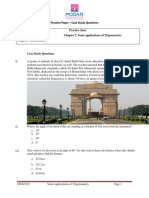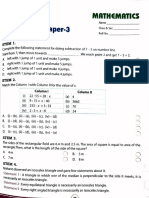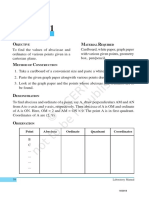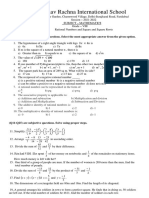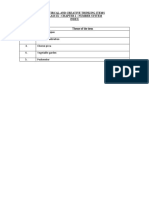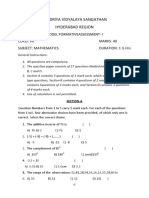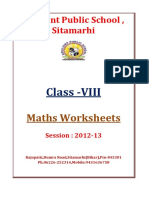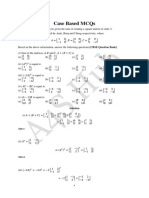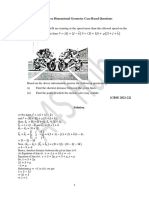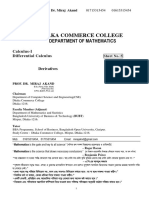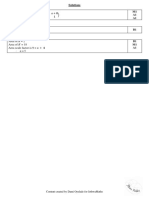Three Dimensional Geometry Assertion-Reasoning Mcqs
Uploaded by
stiwari638859Three Dimensional Geometry Assertion-Reasoning Mcqs
Uploaded by
stiwari6388591
Three Dimensional Geometry Assertion-Reasoning MCQs
Directions- Each of these questions contains two statements : Assertion (A) and Reason (R). Each of
these questions has four alternative choices in which any one of them is the correct answer. You have
to select one of the codes (a), (b), (c) and (d) given below.
(a) 𝑨 is true, 𝑹 is true; 𝑹 is a correct explanation for 𝑨.
(b) 𝑨 is true, 𝑹 is true; 𝑹 is not a correct explanation for 𝑨.
(c) 𝑨 is true; 𝑹 is false.
(d) 𝑨 is false; 𝑹 is true.
1. Statement-1: (Assertion): If a is an integer, then the straight lines
𝑟⃗ = 𝑖̂ + 2𝑗̂ + 3𝑘̂ + 𝜆(𝑎𝑖̂ + 2𝑗̂ + 3𝑘̂) and 𝑟⃗ = 2𝑖̂ + 3𝑗̂ + 𝑘̂ + 𝜇(3𝑖̂ + 𝑎𝑗̂ + 2𝑘̂)
intersect at a point for 𝑎 = −5.
Statement-2: (Reason): Two straight lines intersect if the shortest distance between
them is zero.
SOLUTION
Ans. (a)
Clearly, statement-2 is true. Given lines pass through 𝑎⃗1 = 𝑖̂ + 2𝑗̂ + 3𝑘̂ and 𝑎⃗2 =
2𝑖̂ + 3𝑗̂ + 3𝑘̂ respectively and are parallel to vectors 𝑏⃗⃗1 = 𝑎𝑖̂ + 2𝑗̂ + 3𝑘̂ and 𝑏⃗⃗2 =
3𝑖̂ + 𝑎𝑗̂ + 2𝑘̂ respectively. If given lines intersect. Then,
𝑎 2 3
S.D. = 0. ⇒ (𝑏⃗⃗1 × 𝑏⃗⃗2 ). (𝑎⃗1 − 𝑎⃗) = 0 ⇒ |3 𝑎 2 |=0
1 1 −2
⇒ 𝑎(−2𝑎 − 2) − 2(−6 − 2) + 3(3 − 𝑎) = 0 2𝑎2 + 5𝑎 − 25 = 0 ⇒
(𝑎 + 5)(2𝑎 − 5) = 0 ⇒ 𝑎 = −5, 5/2
𝑥−1 𝑦+3 𝑧−2 𝑥−2 𝑦−1 𝑧+3
2. The equations of two straight lines are = = and = =
2 1 −3 1 −3 2
Statement-1: (Assertion): The given lines are coplanar.
2𝑟 − 𝑠 = 1
Statement-2: (Reason): The equations 𝑟 + 3𝑠 = 4 are consistent.
3𝑟 + 2𝑠 = 5
SOLUTION
Ans. (a)
The coordinates of arbitrary points on the given lines are (2𝑟 + 1, 𝑟 − 3, −3𝑟 + 2)
and (𝑠 + 2, −3𝑠 + 1, 2𝑠 − 3) respectively. Given lines will intersect (be coplanar), if
2
2𝑟 + 1 = 𝑠 + 2, 𝑟 − 3 = −3𝑠 + 1 and−3𝑟 + 2 = 2𝑠 − 3 are consistent i.e. 2𝑟 − 𝑠 =
1, 𝑟 + 3𝑠 = 4 and 3𝑟 + 2𝑠 = 5 are consistent.
Clearly, values of r and s obtain from any two equations satisfy the third equation. So,
these equations are consistent.
Hence, both the statements are true and statement-2 is a correct explanation for
statement-1.
𝑥 𝑦 𝑧
3. Statement-1: (Assertion): The shortest distance between the lines 2 = −1 = 2 and
𝑥−1 𝑦−1 𝑧−1
= = is √2.
4 −2 4
Statement-2 (Reason): The shortest distance between two parallel lines is the
perpendicular distance from any point on one of the lines to the other line.
SOLUTION
Ans. (a)
𝑥 𝑦 𝑧
Clearly, statement-2 is true. Line 2 = −1 = 2 passes through the origin O and the line
𝑥−1 𝑦−1 𝑧−1
= = passes through A (1, 1, 1) and is parallel to the vector 𝑏⃗⃗ = 4𝑖̂ − 2𝑗̂ +
4 −2 4
4𝑘̂.
|𝑂𝐴.𝑏| ⃗⃗⃗⃗⃗⃗⃗ ⃗⃗ |4−2+4|
Clearly, AL = Projection of OA on 𝑏⃗⃗ = |𝑏⃗⃗| = =1
√16+4+16
2
∴ 𝑂𝐿 = √|𝑂𝐴
⃗⃗⃗⃗⃗⃗| − 𝐴𝐿2 = √3 − 1 = √2
Hence, statement-1 is true and statement-2 is a correct explanation for statement-1.
You might also like
- CLASS 12 MATHS Minimum Learning Material KVS Ernakulam PDFNo ratings yetCLASS 12 MATHS Minimum Learning Material KVS Ernakulam PDF83 pages
- Assignment of Matrx and Determinants - XII - 2024-25No ratings yetAssignment of Matrx and Determinants - XII - 2024-253 pages
- Class 10th Maths Chapter - 3 (Test Paper - 4) - Learners InstituteNo ratings yetClass 10th Maths Chapter - 3 (Test Paper - 4) - Learners Institute13 pages
- CLASS 12 Mathematics - Lesson - Plan - 2024-25No ratings yetCLASS 12 Mathematics - Lesson - Plan - 2024-253 pages
- 1692343286289.QP - CB - X - Math - CH 9. Some Applications of Trigonometry - Case Study QuestionsNo ratings yet1692343286289.QP - CB - X - Math - CH 9. Some Applications of Trigonometry - Case Study Questions3 pages
- (MATHS) RevAssign - Annual Exam-9-22-23No ratings yet(MATHS) RevAssign - Annual Exam-9-22-2339 pages
- Maths Class Xi Sample Paper Test 02 For Annual Exam 2022 23No ratings yetMaths Class Xi Sample Paper Test 02 For Annual Exam 2022 235 pages
- CBSE Class 9 Maths Lab Manual Activity 1 To 10 in EnglishNo ratings yetCBSE Class 9 Maths Lab Manual Activity 1 To 10 in English27 pages
- CBSE Test Paper 04 Chapter 7 Coordinate GeometryNo ratings yetCBSE Test Paper 04 Chapter 7 Coordinate Geometry9 pages
- CLASS - IX Mathematics (Co-Ordinate Geometry) : Material Downloaded From - 1 / 7No ratings yetCLASS - IX Mathematics (Co-Ordinate Geometry) : Material Downloaded From - 1 / 77 pages
- CBSE Class 12 Mathematics Matrices and Determinants Worksheet Set JNo ratings yetCBSE Class 12 Mathematics Matrices and Determinants Worksheet Set J3 pages
- Statement and Assertion Real Numbers Class 10No ratings yetStatement and Assertion Real Numbers Class 104 pages
- CBSE Maths Projects Manual - Class 9-10 - Module 2No ratings yetCBSE Maths Projects Manual - Class 9-10 - Module 222 pages
- CBSE Class 11 Mathematics Worksheet (2) - 3100% (1)CBSE Class 11 Mathematics Worksheet (2) - 32 pages
- Class VII Maths Sitamarhi Talent Search 2013 - 1 PDF100% (1)Class VII Maths Sitamarhi Talent Search 2013 - 1 PDF23 pages
- COMMON PERIODIC TEST - 1 (2020-2021) MathematicsNo ratings yetCOMMON PERIODIC TEST - 1 (2020-2021) Mathematics10 pages
- Maths Class 11 HOTS Important Question 22No ratings yetMaths Class 11 HOTS Important Question 228 pages
- XII MATHS QP 65-6-1, 65-6-2, 65-6-3 (Panchkula, Chennai, Guwahati)100% (1)XII MATHS QP 65-6-1, 65-6-2, 65-6-3 (Panchkula, Chennai, Guwahati)37 pages
- Students' Support Material-Class-XII (Maths)No ratings yetStudents' Support Material-Class-XII (Maths)136 pages
- X Cbse Maths Art Integrated Project DetailsNo ratings yetX Cbse Maths Art Integrated Project Details7 pages
- NSEJS Question Paper 2023 With SolutionNo ratings yetNSEJS Question Paper 2023 With Solution20 pages
- CBSE Class 6 Mathematics Sample Paper Set G - 0No ratings yetCBSE Class 6 Mathematics Sample Paper Set G - 03 pages
- Maths Class X Periodic Test II Sample Paper 03No ratings yetMaths Class X Periodic Test II Sample Paper 033 pages
- MS_MATHEMATICS_XII_I PB-07-12-24_241208_170757No ratings yetMS_MATHEMATICS_XII_I PB-07-12-24_241208_1707577 pages
- Cbse Sample Paper For Class 7 Mathematics Fa2No ratings yetCbse Sample Paper For Class 7 Mathematics Fa24 pages
- Introduction To Euclids Geometry Maths Mcqs With AnswersNo ratings yetIntroduction To Euclids Geometry Maths Mcqs With Answers5 pages
- CBSE Class 9 Maths Chapter 7 - Triangles Important Questions 2023-24100% (1)CBSE Class 9 Maths Chapter 7 - Triangles Important Questions 2023-2476 pages
- Important Questions For CBSE Class 12 Maths Chapter 3100% (1)Important Questions For CBSE Class 12 Maths Chapter 313 pages
- CBSE Class 11 Assignment For Sequences and SeriesNo ratings yetCBSE Class 11 Assignment For Sequences and Series7 pages
- CBSE Class 10 Maths (30!5!3) Set-3 Question Paper (Solved) PDF DownloadNo ratings yetCBSE Class 10 Maths (30!5!3) Set-3 Question Paper (Solved) PDF Download56 pages
- CBSE Class 9 Mathematics Worksheet - Coordinate GeometryNo ratings yetCBSE Class 9 Mathematics Worksheet - Coordinate Geometry5 pages
- Maths Class Xii Sample Paper Test 02 For Board Exam 2024No ratings yetMaths Class Xii Sample Paper Test 02 For Board Exam 20246 pages
- Kendriya Vidyalaya Gachibowli, Gpra Campus, Hyd-32: SAMPLE PAPER TEST 03 (2019-20)No ratings yetKendriya Vidyalaya Gachibowli, Gpra Campus, Hyd-32: SAMPLE PAPER TEST 03 (2019-20)4 pages
- Brilliant Public School, Sitamarhi: Class - VIIINo ratings yetBrilliant Public School, Sitamarhi: Class - VIII46 pages
- Reason: The Unit Vector Perpendicular To Both The Lines L1 and L2 IsNo ratings yetReason: The Unit Vector Perpendicular To Both The Lines L1 and L2 Is2 pages
- Case Based MCQS: 1. Amit, Biraj and Chirag Were Given The Task of Creating A Square Matrix of Order 2No ratings yetCase Based MCQS: 1. Amit, Biraj and Chirag Were Given The Task of Creating A Square Matrix of Order 219 pages
- Application of Integrals Case Based Questions 1. A Child Cut A Pizza With A Knife. Pizza Is Circular in Shape Which Is Represented by100% (1)Application of Integrals Case Based Questions 1. A Child Cut A Pizza With A Knife. Pizza Is Circular in Shape Which Is Represented by3 pages
- Vector Algebra Case Based Questions 1. A Building Is To Be Constructed in The Form of A Triangular Pyramid, ABCD As Shown in100% (1)Vector Algebra Case Based Questions 1. A Building Is To Be Constructed in The Form of A Triangular Pyramid, ABCD As Shown in3 pages
- Differential Equations Case Based Questions 1. in A College Hostel Accommodating 1000 Students, One of The Hostellers Came in0% (1)Differential Equations Case Based Questions 1. in A College Hostel Accommodating 1000 Students, One of The Hostellers Came in3 pages
- Three Dimensional Geometry Case Based QuestionsNo ratings yetThree Dimensional Geometry Case Based Questions4 pages
- Maxwell's Equations - Simple English Wikipedia, The Free EncyclopediaNo ratings yetMaxwell's Equations - Simple English Wikipedia, The Free Encyclopedia7 pages
- The Structures of Mathematical Physics: An Introduction 1st Edition Steven P. Starkovich download100% (1)The Structures of Mathematical Physics: An Introduction 1st Edition Steven P. Starkovich download30 pages
- Unit I Wave Mechanics & X-Ray Diffraction Tutorial100% (1)Unit I Wave Mechanics & X-Ray Diffraction Tutorial2 pages
- Laboratorio #1: Transferencia de Energía Térmica: Oscar O Rodrigo Oñate Gustavo Padilla Javier VegaNo ratings yetLaboratorio #1: Transferencia de Energía Térmica: Oscar O Rodrigo Oñate Gustavo Padilla Javier Vega12 pages
- Tensor Operators and Their ApplicationsNo ratings yetTensor Operators and Their Applications200 pages
- Four Laws That Drive The Universe: Peter AtkinsNo ratings yetFour Laws That Drive The Universe: Peter Atkins48 pages
- 1. R-22 Model question paper(ODE&VC) Dr.Anita mamNo ratings yet1. R-22 Model question paper(ODE&VC) Dr.Anita mam2 pages
- Immediate download Math 311 Custom Edition for Texas A M University College Station Steven J Leon And Susan Jane Colley ebooks 2024100% (1)Immediate download Math 311 Custom Edition for Texas A M University College Station Steven J Leon And Susan Jane Colley ebooks 202467 pages
- Fundamental Concepts of Real Gas DynamicsNo ratings yetFundamental Concepts of Real Gas Dynamics114 pages
- (Ebook) Property ($T$) for Groups Graded by Root Systems by Mikhail Ershov; Andrei Jaikin-Zapirain; Martin Kassabov ISBN 9781470441395, 147044139X download pdf100% (5)(Ebook) Property ($T$) for Groups Graded by Root Systems by Mikhail Ershov; Andrei Jaikin-Zapirain; Martin Kassabov ISBN 9781470441395, 147044139X download pdf81 pages
- Linear Algebra 4th Edition Kunquan Lan instant downloadNo ratings yetLinear Algebra 4th Edition Kunquan Lan instant download49 pages
- Zlib - Pub Quantum Mechanics An IntroductionNo ratings yetZlib - Pub Quantum Mechanics An Introduction569 pages











